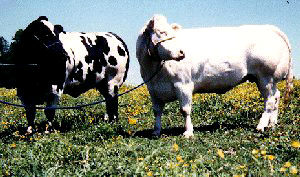
Also Known By: Race de la Moyenne et Haute Belgique, Belgian Blue-White, Belgian White and Blue Pied, Belgian White Blue, Blue, Blue Belgian.
These cattle originated in central and upper Belgium and they, at one time, accounted for nearly half of the cattle in the national herd. Local red-pied and black-pied cattle were crossed with Shorthorn cattle imported from England from 1850 through 1890. Some sources also site the introduction of Charolais breeding throughout the 19th century. A true breeding policy was established in the early 20th century when the breed was established. At one time the breed was divided into two strains, one primarily for milk production and the other a beef animal. Selection is now primarily for beef.

The Belgian Blue Breed of beef cattle is relatively new to the United States but is rapidly gaining acceptance with beef breeders and dairymen. Belgian Blue cattle as they exist today are the result of selective genetic breeding and development conducted in Belgium by Professor Hanset at the AI Center in the Province of Liege. In the late fifties, a debate arose among the breeders, the question being whether to maintain the dual-purpose type as it was or to select for more muscling. The muscling prevailed. Concerning this critical period, three famous AI sires are to be cited: Gedeon and two of his grandsons Ganache and Vaiseur. From them came the model of the breed.
The Belgian Blue is a large sized animal with rounded outline and prominent muscles. The shoulder, back, loin and rump are heavily muscled. The back is straight, rump is sloping, tail set is prominent and skin is fine. It has fine but strong legs and can walk easy.
The color can be white, blue roan or sometimes black. The breed is known for its quiet temperament. Weight and height of animals recorded averages:
|
|
Males |
Females |
||
|
12 months |
1047 lbs. |
47.2" |
816 lbs. |
45.3" |
|
24 months |
1709 lbs. |
53.2" |
1102 lbs. |
48.0" |
European comparisons between the Belgian Blue and Charolais found the Belgian Blue to have a higher muscularity, milk yield and daily gain. The Belgian Blue animals were also older at sexual maturity. Calving interval and calf mortality was approximately equal and Belgian Blue performed lower in calving ease and calving rate. Some sources stated that delivery in Belgian Blue cows is often by caesarean.
Results of studies conducted in Belgium show that the carcass characteristics of the Belgian Blue were expressed in the crossbreds whose commercial value was then substantially increased.
The observation explains the growing interest for the Belgian Blue breed as a terminal sire, it's carcass composition and it's growth potential.

In an extensive 3 year test, done by the USDA at the Meat Animal Research Center, Clay Center, Nebraska, the Belgian Blue crossbred cattle were tested with the industry standard Warner-Brazner shear test for tenderness. The Belgian Blue cattle had a lower shear value than the Hereford-Angus contemporary average, 12.8 versus 12.9, with comparable tenderness and flavor on the sensory panel. Belgian Blue cattle also exhibited less than half the fat cover, .21 inch cover versus .45 inch cover, a 53% reduction. Belgian Blue is on line for the new standards. The Belgian Blue also showed 16% less marbling and 14.2 more ribeye area than the average carcass.
American Belgian Blue Breeders, Inc.
American Belgian Blue Breeders, Inc.
European Association for Animal Production, Animal Genetic Data Bank
Genus Bos: Cattle Breeds of the World, 1985, MSO-AGVET (Merck & Co., Inc.), Rahway, N.J.
Mason, I.L. 1996. A World Dictionary of Livestock Breeds, Types and Varieties. Fourth Edition. C.A.B International. 273 pp.
American Belgian Blue Breeders, Inc.